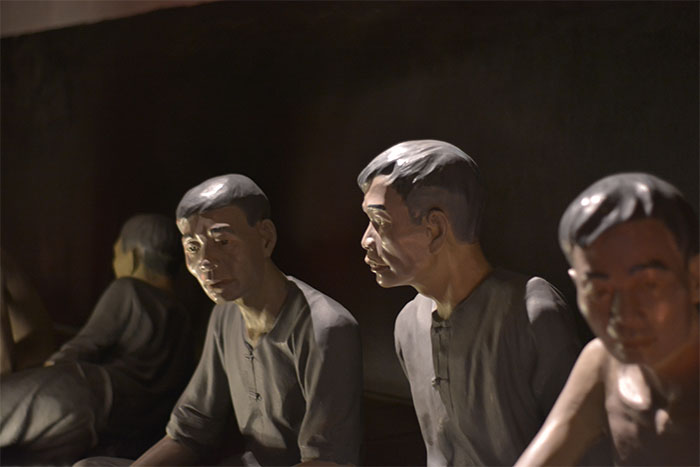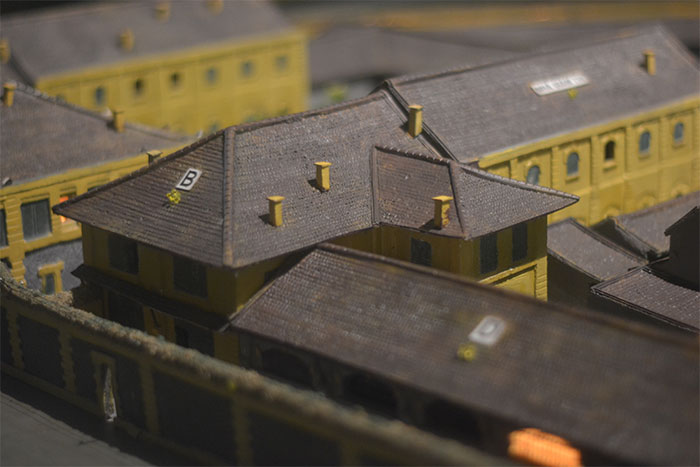
Hanoi, being the most historically packed city in Vietnam, holds many artifacts of the time that passed. Among them is Hoa Lo prison. A place with much significance to the postmodern history of Vietnam. So tag along with us to see what this site has to offer.
1. Where is Hoa Lo Prison
Hoa Lo Prison, often referred to as the "Hanoi Hilton", stands as a somber reminder of Vietnam's turbulent past. Nestled in the heart of Hanoi, this former Hanoi prison was originally constructed by the French colonialists on the grounds of the old Hoa Lo village. Today, it's located at 1 Hoa Lo Street, in the Tran Hung Dao Ward of the Hoan Kiem District.
With its storied history, Hoa Lo Hanoi gained notoriety for its role in incarcerating numerous Vietnamese revolutionaries during the Indochina War and American pilots throughout the Vietnam War. Its significance as a historical site was officially recognized by the Ministry of Culture, Sports, and Tourism in Decision No. 1543-QD/VH, dated June 18, 1997.
As you step into the confines of Hoa Lo Prison, you can't help but feel the weight of its past. Each cell holds echoes of the struggles endured by those who were once imprisoned here. From the cramped quarters to the haunting remnants of confinement, every corner tells a tale of resilience and sacrifice.
Exploring the corridors of Hoa Lo offers visitors a glimpse into Vietnam's fight for independence and the resilience of its people in the face of adversity. It's a journey through history that leaves a profound impact, reminding us of the human spirit's capacity to endure and overcome.
Whether you're drawn to its historical significance or seeking a deeper understanding of Vietnam's past, a visit to Hoa Lo Prison promises to be a poignant and thought-provoking experience. It's a testament to the enduring legacy of those who fought for freedom and justice, etched into the walls of this solemn institution.
2. The history of Hoa Lo Prison
a. In the French colonial period

Initially constructed in the Hoa Lo village, which specialized in pottery and kilns, the prison quickly gained notoriety for its formidable design and formidable reputation. Spanning an impressive 12,908 square meters, it served as a central detention facility for both Tonkin and Annam, earning its French moniker, Maison Centrale.
Divided into four distinct zones, each area of Hoa Lo Hanoi Prison served a specific purpose. Zones A and B housed prisoners awaiting trial and dangerous offenders, while Zone C was reserved for French or foreign detainees. The most chilling area, Zone D, was where death row inmates awaited their fate, either through execution or sentence reduction.
Surrounded by a formidable stone wall adorned with shards of glass and electric wires, escape from Hoa Lo was virtually impossible. Despite its grim exterior, this Hanoi prison was equipped with state-of-the-art tools of torture and punishment, designed to break the spirit of Vietnamese patriots and revolutionaries.
Hoa Lo Prison quickly became a symbol of resistance, with the majority of its inmates being political dissidents and freedom fighters opposed to French colonial rule. Even in the face of brutal repression and relentless torture, these brave souls refused to yield, transforming the prison walls into a beacon of resilience and defiance.
While many lost their lives within its confines, their unwavering commitment to the revolutionary cause inspired countless others to join the fight for independence. Hoa Lo Hanoi thus became more than just a place of confinement; it became a symbol of hope and solidarity for the Vietnamese people.
Today, as visitors walk through the corridors of this historic landmark, they are transported back in time to an era of struggle and sacrifice. The echoes of the past resonate within its walls, reminding us of the resilience and determination of those who fought for freedom and justice.
b. In the war against the US
During the Vietnam War era, Hoa Lo Prison underwent a transformation, earning the nickname "Hanoi Hilton" among American pilots who found themselves detained there. From 1964 to 1973, this notorious facility, known officially as Camp Hoa Lo, served as a holding center for captured American military personnel.
Managed by the Vietnamese military, Camp Hoa Lo had a dual purpose: to detain American prisoners and to ensure their safety amid the ongoing conflict. Despite its grim reputation, the prison's guards organized activities to help the American captives abide by camp rules while providing them with opportunities to reflect on their involvement in the war and immerse themselves in Vietnamese culture.
Behind the scenes, support teams worked tirelessly to cater to the needs of both the camp's personnel and the American prisoners. As the number of captured pilots increased, efforts were made to enhance the culinary offerings, with some personnel even receiving training at the Phu Gia Hotel to prepare meals specifically for the American detainees.
However, the work carried out within the camp was shrouded in secrecy, as officers and soldiers tasked with managing the American prisoners were required to keep their duties confidential, even from their own families.
Despite the challenging circumstances, the efforts made within Camp Hoa Lo reflected a commitment to upholding humanity amid the chaos of war. This lesser-known aspect of this Hanoi prison's history offers a glimpse into the complexities of the Vietnam War and the resilience of those caught up in its tumultuous events.
c. In the modern time
In the aftermath of the Paris Peace Accords signed in 1973, a peculiar silence enveloped the issue of war crimes allegedly committed in North Vietnam. Despite the tumultuous history, by the turn of the millennium, Vietnam adopted a stance claiming that reports of torture at places like Hoa Lo Prison were nothing but fabrications. This change in narrative seemed to be part of a larger effort to mend fences with the United States.
Tran Trong Duyet, a figure embedded in the prison's history, asserted in 2008 that no inmates suffered torture during his tenure as a warden at Hoa Lo. However, contrasting accounts from American military personnel painted a starkly different picture of their time in captivity.
Fast forward to 1993, Vietnam's bustling capital, Hanoi, was on the brink of development. The government decided to repurpose a section of Hoa Lo Prison to make way for a modern commercial high-rise, aptly named Hanoi Tower. The prison complex itself was relocated to Xuan Phuong, Cau Dien, Nam Tu Liem District, and was rebranded as Detention Camp No. 1 under the Hanoi City Police Department.
Today, only a fraction of Hoa Lo Hanoi remains intact, meticulously preserved as the Hoa Lo Prison Memorial Site. Here, visitors are greeted with solemn monuments paying homage to the patriotic souls who perished within its walls. From reconstructed models illustrating the harsh realities of life in captivity to the haunting guillotine used by French colonialists, the memorial site serves as a poignant reminder of Vietnam's tumultuous past.
But Hoa Lo Hanoi is more than just a relic; it's a living testament to the resilience and unwavering spirit of Vietnam's revolutionary soldiers. It stands as a symbol of their endurance in the face of adversity and as a stark indictment of the oppressive colonial regime that once ruled over Vietnam.
Today, Hoa Lo Prison has transcended its dark past to become a beacon of enlightenment. As a "Red Address," it serves as an educational oasis, instilling patriotic fervor and revolutionary ideals in visitors of all ages, especially the capital's vibrant youth. It's a place of reflection, learning, and remembrance, drawing countless domestic and international visitors eager to delve into Vietnam's rich history.
3. Some tips for your visit to Hoa Lo Prison
Visiting Hoa Lo Prison is a sobering yet enlightening experience that offers valuable insights into Vietnam's history. Here are some tips to make the most of your visit:
Plan Your Visit: Before heading to Hoa Lo Prison, check the opening hours and any special events or closures that may affect your visit. It's typically open to visitors during regular museum hours.
Learn About the History: Take some time to research the historical significance of Hoa Lo Prison before your visit. Understanding its role during the French colonial period and the Vietnam War will enrich your experience.
Respect the Site: Remember that Hoa Lo Prison is a solemn memorial site. Show respect for the solemnity of the place by maintaining a quiet and reverent demeanor during your visit.
Dress Appropriately: As with any historical site or museum, it's essential to dress respectfully. Avoid wearing revealing clothing or clothing with offensive language or symbols out of respect for the significance of the site.
Take Your Time: Give yourself plenty of time to explore the museum thoroughly. Take your time reading the exhibits, examining artifacts, and reflecting on the stories of the prisoners who were held there.
Consider a Guided Tour: If available, consider joining a guided tour of Hoa Lo Prison. Knowledgeable guides can provide additional context, answer questions, and offer insights that you might not discover on your own.
Visit the Memorial Site: Pay your respects at the memorial site within Hoa Lo Prison, which commemorates the sacrifices made by those who were imprisoned there.
Reflect on the Experience: After your visit, take some time to reflect on what you've learned and the emotions you've experienced. Consider the historical significance of the site and its relevance to contemporary issues.
Support Preservation Efforts: Consider making a donation to support the ongoing preservation efforts at Hoa Lo Prison. Your contribution can help ensure that future generations can continue to learn from this important historical site.
Explore Nearby Attractions: Since Hoa Lo Prison is located in the heart of Hanoi, take the opportunity to explore other nearby attractions, such as the Old Quarter, Hoan Kiem Lake, and the Hanoi Opera House, to make the most of your visit to the city.
By following these tips, you can make the most of your visit to Long Bien Bridge and enjoy all that this historic landmark has to offer. If an authentic trip to Hoa Lo Prison is what you are after, then don't hesitate to contact us : AUTOUR ASIA -
Vietnam Travel Agency to ensure you the voyage of your dream.
You might be interested in:




























